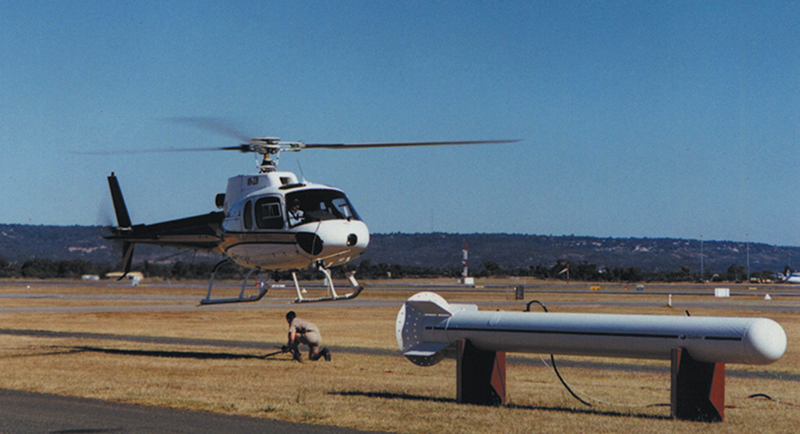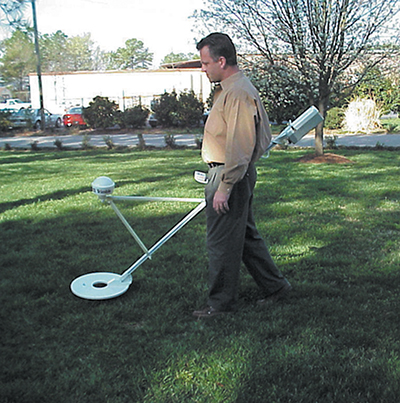
Not Your Ordinary GEM
You could really say that Geophex, Ltd., of Raleigh, North Carolina, has a lot of sense—or maybe, sensors. Through Small Business Innovation Research (SBIR) funding from NASA's Stennis Space Center, Geophex devised a new design for broadband electromagnetic sensors. NASA's original goal was to find an advanced airborne electromagnetic remote sensor to monitor various coastal environments. To meet this goal, Geophex developed a patented sensing technology, capable not only of coastal monitoring, but also a variety of other functions, including environmental pollution characterization, groundwater contamination detection, archaeological study, and mineral detection. The new technology is offered in several of the company's products—the GEM-2, GEM-2A, and the GEM-3.
The Geophex products consist of two primary electromagnetic coils, which are stimulated by alternating currents that generate a magnetic field in the object targeted for investigation. An electromagnetic sensing coil that measures the magnetic field induced in the target is also needed. While other apparatuses have been constructed with these same general components, Geophex's sensor has been drastically compacted, and yet still contains the needed specifications of a sensor instrument.
In the Geophex version of sensing technology, the coils are situated in close proximity of each other. Previously, the coils were placed as far apart as possible, making for a rather large instrument. This distance was thought to be necessary in order to prevent the excitatory magnetic field of the primary coil from overwhelming the relatively weak field of the sensing coil. Geophex's compact size is achieved through the use of a concentric design where the smaller sensing coil is placed within the larger primary coils, creating a magnetic cavity at the center of two concentric loops, allowing for the accurate detection of weaknesses in electromagnetic fields.
Geophex creates products of unrivaled accuracy and efficiency in a wide range of Earth-related fields. For instance, the GEM-2 is a handheld, lightweight, programmable, digital device. It consists of a broadband electromagnetic sensor, a rechargeable battery, and operating software. Characteristics like its advanced sensing ability and compact size make the GEM-2 ideal for smaller geological and environmental surveys. In one noted case, the GEM-2 was used to rediscover decades-old radioactive waste that had been buried in Tennessee.
The same sensing capabilities are offered in the GEM-2A, an airborne version of the sensor. Suspended from a helicopter, the GEM-2A is used to search for mineral deposits and to survey large tracts of land. One Australian mining company succeeded in its search for diamond deposits and other precious and base metals by employing the GEM-2A.
The third version of this technology is exhibited in the GEM-3. Like the other GEM products, it can be used for environmental site characterization, but it also has another unique function. The GEM-3 is capable of detecting buried landmines and other active munitions. While other products are able to perform similar functions, the GEM-3 goes above and beyond their capabilities by identifying landmines by their brand names. Because each landmine has its own unique electromagnetic response to the broad frequency band emitted by the GEM-3, bomb identification and disposal strategies are made easier.
While Geophex has enormous success with these products, more is yet to come. It is hoped, future applications of this technology will allow for the detection and identification of concealed weapons. Medical-related applications include using tomography to image the conductivity of the body. This technology also has the potential for detecting water and other fundamental resources necessary for establishing human colonies on other planets. Based on the success of the GEM family of sensors, NASA's Jet Propulsion Laboratory has awarded Geophex a contract for the development of an electromagnetic sensor to be mounted on a Martian rover. Sensor technology will help us map out opportunities in space, as we continue to map out those here on Earth.

The GEM-3 can be used for detecting and identifying buried unexploded ordnance and landmines. Each landmine shows a distinct electromagnetic response in a broad frequency band, which can be used as a fingerprint to identify it by its brand name.

The GEM-2A airborne sensor is commercially used for surveying large areas of land, in search of minerals, metals, and hydrocarbons.













